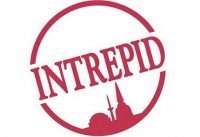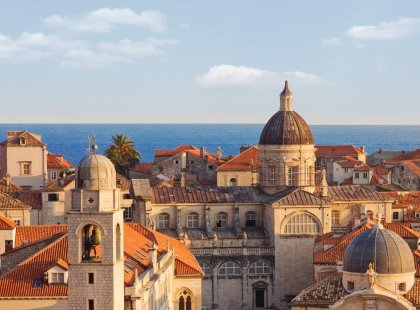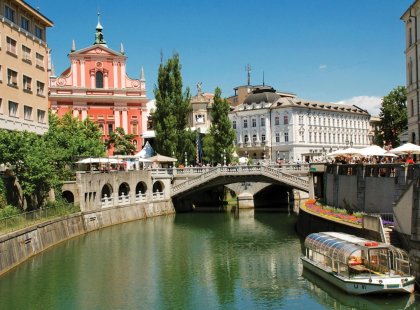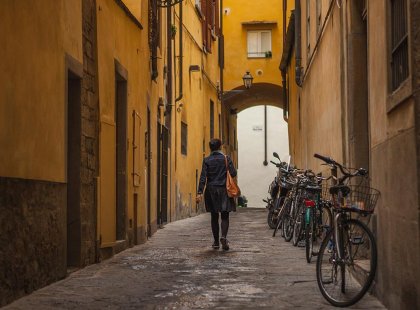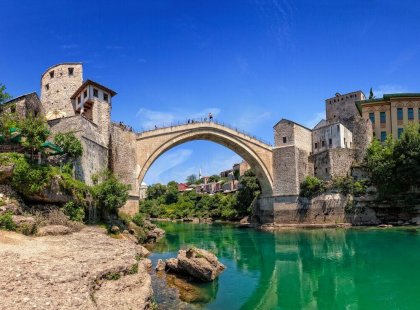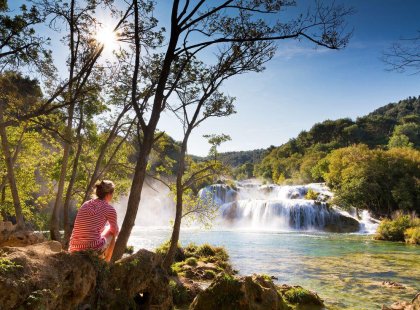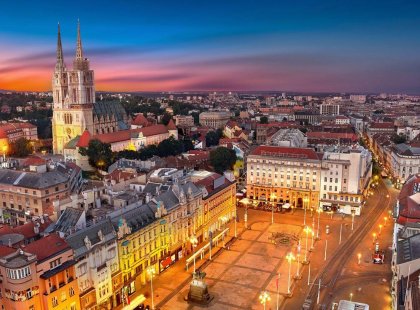Budapest to Rome
26 days
From
$ 4280
Duration26 days
See the sights and soak up the excitement of eastern Europe and the Balkans. Grand standing capitals and quaint seaside villages, hidden mountain hamlets and a city set on water – eastern Europe covers a pretty impressive gauntlet of visitor attractions. Discover the mainstay allures of this entrancing region, plus a whole host of its lesser-known aspects, making your way down from Hungary through the Balkans and east over to Italy. Encounter the up-and-up vibe of once war-ravaged Sarajevo, fall in love with gorgeous Dubrovnik, kick into adventure mode in Ljubljana and feast until your belly's content in gastronomy-obsessed Italy.
-
Duration: 26 daysService level: Basic
-
Physical Grading: Light
-
Ages: 15+
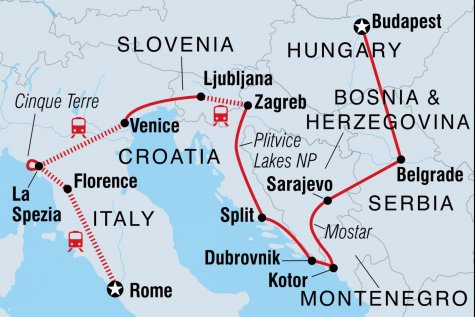
Itinerary
Day 1: Budapest
Szia! Welcome to Hungary. Budapest is Hungary's intoxicating capital, on the banks of the Danube River. In the evening after the welcome meeting perhaps head out with your new travel buddies and your leader for dinner, then take a night walk along the Danube River to see the surrounding buildings and bridges lit up in lights. Not to be missed are Budapest's funky 'ruin pubs'.
Day 2: Budapest
This morning you have the option to join your leader on a short orientation walk of the city. Afterwards you have a full free day to explore Budapest, known as 'The Pearl of the Danube'. Admire intricate carvings on resplendent buildings, cross the iconic Chain Bridge to explore the Castle District, or simply meander through winding streets snacking on local delicacies. Budapest is a great city to enjoy from the water. Perhaps take a boat trip along the river or catch a funicular up to the castle for spectacular views of the Parliament Building. With so much to see and do, hiring a bicycle is another great way to move between the sights. Perhaps head to Statue Park to see the communist monuments that were removed from the city after the fall of the Iron Curtain. You might like to take a tour of the beautiful Hungarian State Opera House, or check out the Hungarian National Museum. One unmissable activity is a soak in the healing waters of Budapest's hot thermal baths. You could also take part in one of our Urban Adventure day tours, such as the Budapest Castle Explorer or Bites and Sights. Check them out at urbanadventures.com.
Meals: B
Day 3: Belgrade
Board your private transport and head to Belgrade, Serbia's surprising capital. Known as the' White City', Belgrade is one of the oldest cities in Europe. Sitting at the confluence of two major rivers, the Sava and the Danube, it’s an important intersection between Eastern and Western Europe. Here you’ll experience an energetic mix of progressive flamboyance and conservative customs. Upon arrival there is the option to join a guided tour. Then you'll have plenty of free time to explore the city. Perhaps begin with a wander around the city’s wide boulevards and squares, and the historic and green heart of Kalemegdan Park. The park is home to Kalemegdan Fortress, which has overlooked the Danube River here for centuries. In the evening, head down to Skadarska Street in the bohemian quarter of Skadarlija to sample some authentic local food and enjoy the lively atmosphere, in a place where Orthodox churches vie for space next to fashionable nightclubs.
Meals: B
Day 4: Belgrade
Today is a free day to further discover Belgrade. You might like to take a cruise along the Danube River, passing the Kalemegdan Fortress, Pancevo Bridge and Zemun. Make sure you visit the imposing Hram Svetog Save (St Sava Church). Alternatively the local market Zeleni Venac can keep you occupied for hours. Perhaps take a stroll through the Nikola Tesla Museum to learn about the life and work of Serbia's greatest inventor, or check out the city's Ethnographic or Military Museums. You can climb the 36-metre, 1896 Gardos tower in Zemun for sweeping views of the city and the Danube, or get a crash course in Serbian contemporary art at Zepter Museum. If the weather is warm, why not brave the crowds on Ada Ciganlija beach, where you can swim, take part in water-sports or simply soak up the sun with a cocktail. Throughout the summer months, Belgrade hosts a variety of musical and cultural events and the city is abuzz with people and activities. The city’s nightlife has become legendary throughout Europe, with several hundred floating bars, restaurants and nightclubs lining the Danube and Sava rivers.
Day 5: Sarajevo
Travel by bus through beautiful countryside to Sarajevo. The journey will take around eight hours in total, so sit back and enjoy the scenery. Sarajevo is Bosnia and Herzegovina's small but vibrant capital. More than twenty years after the end of a devastating war, Sarajevo is slowly asserting itself as one of Europe's most beautiful and interesting destinations. The city often draws comparisons with Istanbul as a place that mixes east and west – dotted with minarets, mosques, bazaars and the aroma of coffee. On arrival, perhaps embark on an optional guided tour to gain insight into the history and culture of the city. Sarajevo is one of the few cities in the world that features an Orthodox church, a Catholic church and a mosque (the famous Begova Džamija) all within close proximity. Make sure you explore Baščaršija, Sarajevo's old bazaar. Out from here the city’s history unfolds – from Ottoman-era buildings to the elaborate constructions of the Austro-Hungarian period and on to the structures of the communists. In the evening perhaps try try the local specialty of bosanski cevapi (grilled minced meat mixed with mild spices).
Day 6: Sarajevo
Enjoy a free day in and around Sarajevo. You could take an optional day trip out to the thermal springs and green parks of Ilidza, the source of the River Bosna. You might prefer to discover local history with a visit to the History Museum and the Sarajevo War Tunnels (dug underneath the airport runway and used to smuggle provisions into the city during its siege) and Sniper Alley, or learn about the tragedies faced by the city's Jews at the Jewish Museum. Perhaps get cultural with a stroll through the Art Gallery of Bosnia and Herzegovina. Perhaps return to Baščaršija and get lost in the mosques, caravanserais, and stone-vaulted bazaars, snacking on burek or ćevapi, or ramble along through Park Prinčeva for views of the city. The Pivnica HS brewery, which also has a restaurant, is a good place to sample local award-winning beer and spend an evening.
Day 7: Mostar / Kotor
Head out of Sarajevo by early morning train to Mostar, a town situated in a beautiful valley in the high mountains of Herzegovina (approximately 3 hours). Thanks to the river Neretva Mostar was able to develop as a city in the barren landscape of Herzegovina. Neretva's size turned Mostar into a trading centre of the region very early on. The city was the most heavily bombed settlement in Bosnia during the war, but it has since been rebuilt and now features on UNESCO's World Heritage list. On arrival, perhaps head to the famous Stari Most (meaning Old Bridge), first built by the Ottomans in 1565 – it was the great architect Mimar Hajrudin who succeeded with the impossible mission to cross the Neretva River with a single span stone bridge. The bridge also made headline news during the Yugoslav wars when it was destroyed in 1993. It was rebuilt and reopened in 2004, and there’s an interesting museum about its history next to the bridge itself. If you’re lucky you’ll see the famous brave members of Mostar’s diving club hurl themselves into the icy waters below. It’s a tradition for the young men of the town to make the jump, and it’s now an annual competition. We advise against having a go yourself though, as the bridge is very high and the water is freezing. You might like to follow local custom and hand the divers a few Marks. Later on today continue to Kotor where you will spend the night (approximately 4 hours).
Day 8: Kotor
Explore Europe's most southerly fjord, Boka Kotorska (Bay of Kotor) and Kotor town, with free time to discover the narrow alleyways by yourself today. This 5th-century World Heritage-listed city is set on a secluded bay, with towering peaks surrounding a rocky coastline dotted with pretty waterside towns. Check out the 12th-century Cathedral of St Tryphun, the South Gates of Kotor (the Gurdich Gate) and the Armoury Square (Trg od oruzija). Afterwards, you might like to get delightfully lost in the crooked alleyways, checking out the boutiques and cafes, or climb the hills behind the city to visit Kotor's ruined fortification walls. A one-and-a-half hour hike up the stone steps, past churches, gates, and bastions to the Fortress of Sveti Ivan at the top rewards you with magnificent views across town and the brooding Bay of Kotor. In the evening the city walls are prettily lit up to provide a unique night-time perspective.
Meals: B
Day 9: Dubrovnik
Depart Montenegro by bus, riding along the beautiful southern coast of Croatia to Dubrovnik (approximately 2,5 hours). The day is free for you to explore Dubrovnik at your own pace. Take a walk along the city walls of ‘Game of Thrones’ fame, enjoying views of the sparkling Adriatic Sea in this renowned jewel of the Dalmatian Coast. Visit Big Onofrio's Fountain, built by architect Onofrio della Cava in the 15th century to supply water to the city. Perhaps check out the 13th-century Franciscan monastery or the Sponza and Rector's Palaces, the only Renaissance buildings in the city to survive a devastating earthquake and fire in 1667. You might like to check out the city's War Photography Museum, or if you have time, even take a boat trip to nearby Lokrum Island, where you will find the French-built Fort Royal Castle, a monastery, and a botanical garden that dates back to when the Austrian archduke Maximilian had his holiday home on the island.
Meals: B
Day 10: Dubrovnik
Today is a free day to explore the beaches and scenery of this idyllic coastal city that overlooks the Adriatic. The walled city of Dubrovnik is a great place to discover on foot, with its cobblestone streets, tiled roofs, white washed walls and stone buildings. Stroll down the main street of Stradun that runs straight through the World heritage listed Old Town, with its baroque monuments and gothic buildings.
Meals: B
Day 11: Dubrovnik
Another free day allows you to delve deeper into this beautiful city. Perhaps check out the city's War Photography Museum, or if you have time, even take a boat trip to nearby Lokrum Island, where you will find the French-built Fort Royal Castle, a monastery, and a botanical garden that dates back to when the Austrian archduke Maximilian had his holiday home on the island. Or perhaps you'd prefer to simply unwind on a beach.
Meals: B
Day 12: Split
Take a public bus up the coast to Split (approximately 5 hours). If Dubrovnik is considered the heart of Dalmatia, Split is certainly its soul. Situated on a small peninsula on the eastern shores of the Adriatic Sea, it's the second largest city in Croatia. Enjoy a free afternoon in this stunning seaside town, exploring the historic streets, and make sure you see the World Heritage-listed Diocletian's Palace. Alternatively, for a more in-depth introduction to this fascinating city why not join an optional guided tour with a local guide.
Meals: B
Day 13: Split
Enjoy a free day in Split. At the heart of its atmospheric Old Town is a fascinating city-within-a-city – the remains of a 3rd-century palace built for Roman Emperor Diocletian. Some places might have protected such an impressive complex in a museum, but not enigmatic Split. These ancient walls now house a vibrant mix of shops, cafes, restaurants and houses. Step back in time strolling its sprawling maze of passageways and courtyards and you’ll also find a 16th-century synagogue and a courtyard often filled with music. If your feet get tired, why not sample Croatia’s fine coffee culture with a frothy kava from a cafe on the Riva waterfront promenade, a prime spot for people watching. In the evening, Split boasts an increasingly bustling nightlife scene.
Day 14: Plitvice Lakes National Park / Zagreb
Today you will visit one of Croatia's most beautiful sites – Plitvice Lakes National Park (approximately 3 hours). The park was given World Heritage status 20 years ago and is 19 hectares of wooded hills that surround 16 stunning turquoise lakes, all connected by a series of waterfalls. The area is populated by deer, bears, wolves, boars and some rare bird species, and the thick, primeval forest vegetation of beech trees, fir spruce and white pine adds another element to the park's beauty. You’ll have free time to explore here or simply follow your leader to see the best spots – all trails in the national park are well marked so it's difficult to get lost, but please follow the national park rules, which your leader will outline to you. A series of wooden walkways pass over the landscape, ensuring that there's as little impact on the park as possible. Look to the canopy for over 120 species of birds, including hawks and owls. After your memorable visit to the lakes, drive to Croatia's capital, Zagreb (approximately 3 hours).
Meals: L
Day 15: Zagreb
Take a morning orientation walk with your leader who will point out local amenities and attractions you might want to visit along the way, so ask any questions you might have about the city during the walk. The rest of the day is free, so check out both the upper town and the lower town to understand the city's culture. The tallest building in town is the gothic Zagreb Cathedral, with iconic twin spires that dominate the city's skyline. Ban Jelacic Square is the city's central point, which is surrounded by multiple structures that reflect different periods of Zagreb's past. There is so much to see and do here, the hard thing is deciding what to choose. There are a number of excellent museums to visit including the quirky Museum of Broken Relationships.
Meals: B
Day 16: Ljubljana
Travel by train across the Slovenian border and arrive in the cosmopolitan capital (pronounced 'Lyub-Li-Yana') (approximately 3 hours). On arrival into Ljubljana, check in to your accommodation and then head out on a short orientation walk with your leader. The rest of the day is free for you to delve deeper into this beautiful city. Located in the centre of Slovenia, Ljubljana is a city full of style and sophistication, history, monuments, churches, museums and great restaurants. In your free time, you can wander around the old city centre, renowned for its unique architectural appearance. The Old Town consists of three main squares and Baroque houses, and you can visit the Ljubljana Castle, the Town Hall, Cathedral of St. Nicholas, and the Dragon Bridge. Stop at the central Preseren Square, dedicated to the Slovenian romantic poet, France Preseren. With views of the Triple Bridge and Ljubljana Castle on one side, and a magnificent Franciscan church on the other, you’ll feel like you’ve walked right into a scene from a beautiful postcard. Maybe also drop by the open market under the arcade.
Meals: B
Day 17: Ljubljana
Today is a free day to further explore Ljubljana. You have the option of going a day trip to Bled. Gifted with immense natural beauty, Bled ranks among the most beautiful of alpine resorts. Its fairy tale-like scenery which includes a castle, a stunning lake and a picturesque island topped with a church, is a dream to explore. Maybe head to the 11th-century cliff-top Bled Castle. Take a Pletna boat ride (a wooden, awning-covered boat rowed by a special oarsman) across sparkling Lake Bled to its island, then climb the 99 steps to St Mary's Church. Be sure to seek out the famous Bled cream cake. It isn’t hard to find; nearly every cafe and cake shop in town claims their cream cake is the best. There's also plenty of action for adrenaline junkies: rafting, caving, cycling, canoeing, boating and swimming, to name a few.
Meals: B
Day 18: Venice
This morning travel by bus to one of the world's most unique cities, legendary, romantic Venice, the final destination of this trip (approximately 3.5 hours). A grand city of canals, Venice is built over a hundred small islands connected by 400 bridges. This watery wonderland of towers, piazzas, canals, churches and gondolas – practically unchanged for 600 years – is literally sinking under the weight of its iconic sights. Still rich with artistic masterpieces, modern Venice combines history with contemporary life through food, performance, art and architecture. The best way to enjoy your free time and explore is by foot, taking in all the famous sights – the Grand Canal, the Rialto Bridge, Doge's Palace (the ruler of Venice), the Piazza San Marco with its golden Basilica, and of course, the evocative Bridge of Sighs. Wander the cobblestone streets and spacious piazzas, crossing hundreds of tiny bridges. There are shops, markets, galleries and churches around every corner. Don't miss taking a gondola trip through the romantic canals or sampling a slice of region's desert speciality, tiramisu (coffee-soaked sponge cake).
Meals: B
Day 19: Venice
Enjoy free time in this watery wonderland of bridges, towers, piazzas, canals, churches and gondolas – practically unchanged for 600 years – is literally sinking under the weight of its iconic sights. Take a walk around the maze of streets behind San Marco square and begin to understand the complex canal system of Venice.
Day 20: Venice
Another free day in Venice allows you to explore further. Perhaps start at the Grand Canal, as you can stroll over the Rialto Bridge and browse the endless amounts of boutique shops that sell Venetian masks and handmade Murano glassware. Venice is famous for its specialities of fresh lobster and squid ink spaghetti dishes, so make sure you give one a try.
Day 21: La Spezia
This morning spend the day travelling by train to the once important naval base of La Spezia, now the gateway to the gorgeous Cinque Terre, or ‘Five lands’ in English. The name comes from the five tiny villages – Monterosso, Vernazza, Corniglia, Manarola and Riomaggiore – whose position, wedged into a series of coves between sheer cliffs, makes it one of the highlights of the whole of Italy. The journey usually takes between five and seven hours either via Milan or via Florence (depending on the best available connection), and is a very scenic trip through the north of Italy. On arrival in La Spezia there won't be too much time to explore yet, but after checking into your hotel perhaps get your bearings of the area with a short walk around the pedestrian zone on Via del Prione to the gardens along the harbour, or head out for dinner with the group.
Day 22: La Spezia / Cinque Terre
Today it is highly recommended to venture out on the footpaths of Cinque Terre (Five Lands), a region of Italy famed for its coastline and pastel villages. The footpaths that run between the villages were once the only way to travel in the region, and take you through olive groves, vineyards and on to idyllic vistas. You can choose to walk just a few sections, which will still unveil a great amount of majestic scenery. Some sections of path can be difficult, as there are challenging uphill stretches, narrow paths, steep cliffs and foot bridges. Please remember to bring comfortable footwear such as trainers or light hiking shoes. It's also possible to take the train between any of the villages or back to the group's base in La Spezia whenever you want. After working up an appetite, take advantage of the foods of the Liguria region with a pesto class. Focaccia is also a speciality in this area and makes a great start to lunch. Upon return to La Spezia in the evening, there's no better way to recover from your day of walking with more indulgence in delicious Mediterranean food.
Meals: B
Day 23: Florence
Depart Cinque Terre today and catch a train to Florence (approximately 3.5 hours). On arrival, check into the hotel and go for a brief walk around the immediate area to get your bearings. Florence is one of the most culturally rich and beautiful cities in Italy, known to many as the beating heart of Tuscany. The Medicis, Leonardo da Vinci, Raphael, Brunelleschi, Machiavelli, Donatello and Michelangelo all lived in Florence at the height of their creative reign. Food is a major part of the city's identity, so perhaps explore some of the culinary delicacies on offer from across Tuscany. Regional specialities are noted for their simplicity and fine flavour, and the use of high-quality olive oil, cannellini beans and fresh herbs. Meat lovers should try the bistecca alla fiorentina, a huge T-bone steak that's usually shared between two people, or ribollita, a thick delicious vegetable soup with bread, beans and greens. Panforte is the signature sweet treat.
Meals: B
Day 24: Florence
Head out into the centre of Florence. It's impossible to see everything in this Renaissance wonderland, however, so take your time and enjoy it. Be captivated by the culture-rich atmosphere of Florence, from family-run vineyards on the outskirts of the city to the Duomo’s magnificent marble facade. Maybe start with a visit the Galleria dell'Accademia where you can see Michelangelo's famous statue of David. Stop by the Uffizi, one of the world's oldest art galleries, or walk up to Piazzale Michelangelo, which is set on a hill on the south bank of the Arno River, to take in beautiful views of the city – a lovely way to while away the day. There are plenty of sights to see during your time in Florence.
Meals: B
Day 25: Rome
In the morning, take the train to Rome (approximately 2 hours), and remember that while here, the best attitude is ‘when in Rome’! Join your leader on an orientation walk around the city, where you see some of the iconic sights such as the Colosseum and Arch of Constantine, the Forum (centre of ancient Rome), the Victor Emmanuel Monument, the Pantheon, Spanish Steps, Via Dei Condotti and Piazza Venezia. Recharge with a slice of pizza and a strong espresso at the Piazza Navona or throw a coin into the Trevi Fountain and make a wish to return to the 'Eternal City'. No visit would be complete without a trip to Vatican City and St Peter's Basilica. Entry to the Basilica is free and there's a small charge to climb the dome for a panorama over the city. Art-lovers should visit the Sistine Chapel to admire the timeless work of Michelangelo, while history buffs will enjoy a jaunt through the ancient halls of the Pantheon. Rome is packed full of restaurants and trattorias that cater to every taste and budget. Local specialities tend to be quite heavy, and include pastas such as carbonara (egg, cheese and bacon) and amatriciana (tomato, bacon and chilli). Eating in trattorias will give you a chance to sample some Italian wines, with house choices usually very good and affordable. Head out in the evening with the group for a final farewell gastronomic fling.
Meals: B
Day 26: Rome
Your adventures comes to an end on the final morning. There are no activities planned for today and you're free to depart the accommodation at any time after check-out. As there is so much to see in Rome we recommend you to stay a little longer. We are happy to book additional accommodation for you (subject to availability). Please speak to your agent at the time of booking.
Inclusions
Included
- Burek Snack in Bascarsija
- Plitvice Lakes National Park
- Picnic in Plitvice Lakes National Park
-
Transport
Train, Public bus, Metro, Private vehicle, Taxi -
Accommodation
Hotel (10 nights), Hostel (11 nights), Pension (4 nights)
